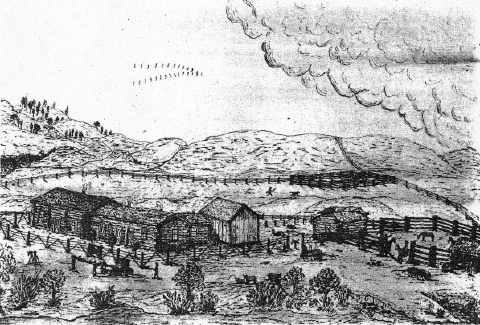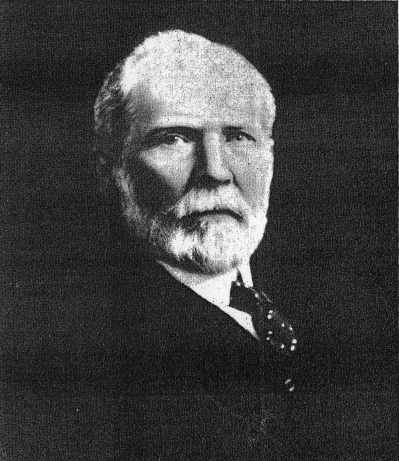
The Newman Ranch (N) on the Niobrara where J. C. Dahlman worked as Cowboy in 1878. (From pen sketch by a young Englishman.)
336
NEBRASKA HISTORY MAGAZINE |
337 |
and water in the valleys; now the great hay meadows of the west.
The Sand Hill Bonanza
I remember well the first bunch of native cattle we struck. They were so wild as any bunch of deer I have ever seen. Irwin and I were the scouts on that day. We rounded up this bunch of cattle and were certainly two surprised cowboys. Here were cattle as fat as any ever brought out of a feed-lot; unbranded Mavericks from one to four years old. We could hardly believe our own eyes. Remember, these cattle had no feed except the native grass; and this was the month of April, after a terrific winter. One cow in this bunch weighed not less than fourteen hundred pounds. As we had been living on fat bacon for several weeks -- and not a very good quality at tha t-- I suggested that we tie down this cow for the night until we could move up the outfit the next day. No sooner said than both of our lassoes came down, the chase started, and before long, I was close enough to throw the rope. I caught the animal the first throw; one end of this lasso was tied to the horn of my saddle, and when the cow, running at full speed, tightened the rope, your humble servant, horse and all, went into a heap. Believe me, there was some mixup. I drew my revolver at once for defense; but Irwin roped her by the hind feet. It did not take us long to hog-tie her, and back to camp we went. The next day we moved the outfit, butchered the cow, and had plenty of fat beef and smiles on our faces.
We moved along, studying the lay of the valleys and rough hills; and began to gather thousands of cattle. We were away five weeks, working day and night, brought in 8000 cattle that had drifted in from our side, and one thousand head of "natives" that had been in there for years; the evidence of this being that we brought out 300 head of unbranded Mavericks from one to four years old. These were awarded to Mr. Newman by our crew, the rule in that day being that the Mavericks belonged to the man whose range they were found on. There was no one who cared to dispute this right.
The news of this trip spread all through the west, and cowmen came from everywhere to hear the story. From that time on, instead of trying to keep the cattle out of the sandhllls in winter time, they were thrown in.
Meets Well-known Men of the Plains
In 1879, while attending roundups on the Platte River, I first met Colonel Frank North, Captain Lute, his brother, and Colonel W. F. Cody. These friendships lasted throughout the lifetime of both Colonel North and Colonel Cody, and I am proud to say -- in the case of old Lute who is with us tonight, it still holds good.
Cattle from Oregon to Nebraska
In the fall and winter of 1880, Mr. Newman contracted for 20,000 cattle in Oregon, to be received in April, 1881. They were to be brought to his Western Nebraska Ranch and to his Montana ranch. He selected all of the foremen to be used in trailing these herds from these two ranches, together with some thirty or forty other cowboys, all of whom he took with him to Oregon to receive the herds. I was one of the foremen
| 338 | NEBRASKA HISTORY MAGAZINE |
selected, and received my herd near Baker City, Oregon. We were some thirty days in receiving the cattle, we could only handle from 150 to 200 each day. The ranchmen would bring them in from their ranches, and on the day we received them, we would brand them. Then we would herd night-and-day until we received about three thousand, before we started on the trail. This, of course, meant all day and all night for the entire crew; and it was the hardest job I ever went up against. The trip took about six months.
Cattle From Indian Territory to Nebraska Agency
In 1883 I received 3000 Texas longhorn steers in the Indian Territory, and trailed them to Standing Rock Agency, Dakota, to be delivered to the Indians. Sitting Bull, with 300 prisoners of war, was held there at the time by the government. This was my first acquaintance with Chief Sitting Bull, Red Cloud, Spotted Tail and others.
Early Settlers of Western Nebraska Now Prominent Nebraskans
In 1883 and '84 the settlers began to move into Western Nebraska, as the railroad extended into the Black Hills and Wyoming. The large ranches moved into Montana, Wyoming and Canada. When the site of Chadron was being located, I settled there. This is where I first met Mr. Sheldon, your secretary, at whose kind invitation Mrs. Dahlman and I have the pleasure and honor of being with you tonight. He is one of the pioneers in the development of Western Nebraska. He and I have fought each other many times in political battles, and many times we have fought together. Mrs. Dahlman and I both rejoice at your success, Mr. Sheldon, in the great work you have been doing in your adopted home here, after leaving dear old Chadron, one of the best and most progressive cities in the west. There is where we first met our fine old friends, Colonel John G. Maher, Chief Justice Andrew Morrissey, Mrs. Fannie O'Linn, and many others who have won fame and distinction. It was there, in 1888, that I first met Mr. William J. Bryan, with whom I later had the honor to be closely identified in his political campaigns.
In 1890, during the Wounded Knee Indian War, I first met General John J. Pershing, who at that time was a young lieutenant. The strong friendship begun then has extended through all of these years.
Those were exciting times for the people along the Northwestern Railroad line in Western Nebraska. The Indians had retreated into the Bad Lands, and the distance from Chadron and vicinity being only a few miles, the settlers came to Chadron and other towns, where we housed and fed them as best we could until the trouble was over. The pioneers had many reverses from time to time, due to drouths, panics, etc., and often the outlook was indeed discouraging.
However, they stayed with the ship, and today Western Nebraska is one of the most productive and prosperous sections of our state. The dreaded sandhllls of 1878 and before, are filled with small ranchmen with their families, and in many of the lakes, which we thought were alkali, immense deposits of potash have been discovered. While, at the present time the markets are not exactly favorable for the development of this industry, the fact remains that millions of tons of this valuable

E. S. Newman, Owner of Newman's Ranch on the Niobrara at Antelope Creek.
338
|
© 2004 for the NEGenWeb Project by Ted & Carole Miller |
||